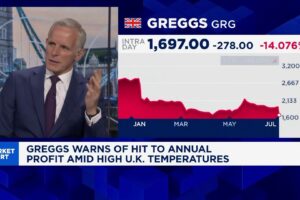
U.S. Secretary of Transportation Pete Buttigieg sat down with Yahoo Finance’s Editor-at-Large Brian Sozzi to discuss the Biden Administration’s American Job’s Plan proposal. Secretary Buttigieg also spoke extensively about the current state of U.S. infrastructure and the future of the electric vehicle industry.
Video Transcript
[MUSIC PLAYING]
BRIAN SOZZI: President Joe Biden is fresh off outlining his signature $2.3 trillion infrastructure package called the American Jobs Plan. About $1.3 trillion of that is earmarked as critical investment in the country’s crumbling outdated infrastructure, namely roads, bridges, and public transportation. Now it’s all hands on deck inside the administration to get the plan passed by Congress.
Joining us now to discuss the plan is Transportation Secretary Pete Buttigieg. Secretary, good to see you here. You call this plan a generational investment. Why is that?
PETE BUTTIGIEG: Because this is about the future that current and future generations are going to be living in. This is not just another plan or another bill. Look, America, at certain moments in our history, has made a decision that we’re going to lay the foundation for a better life.
It happened with the Erie Canal that helped unite this country, the transcontinental railroad under President Lincoln, the interstate system under President Eisenhower. And I think this is one of those moments comes along once every 50 or even once every 100 years to really set us up for success in the future or, as the president said, to make a decision that this is when we choose to win the future for the rest of this century.
BRIAN SOZZI: Now that you’ve had time to settle into this role and see the state of our– our transportation infrastructure, how bad is it, really?
PETE BUTTIGIEG: You know, our department does research on the conditions across our different transportation infrastructure assets. And the bottom line is, they’re not good enough. We’ve got about $1 trillion backlog just to fix what we’ve got. Anyone who has traveled to other countries and seen the conditions of airports there or trains there compared to how they are in the US knows we’ve got a lot of work to do.
But you don’t have to be a world traveler to know that the condition of our roads and bridges is pretty rough too. The American Society of Civil Engineers keeps putting out their report cards. We’re getting a lot of Cs and Ds. And frankly, that’s not sustainable if we aim to be the leading country in the world. This really is a decision about whether we’re going to be the leading country in the world or just another country out there. And there is simply no way that America can compete and be number one in the world if our infrastructure remains number 13, which is the most recent ranking I’ve seen of where we stand with respect to our peers and our competitors.
BRIAN SOZZI: What area of our infrastructure, from a transportation perspective, are you most concerned about?
PETE BUTTIGIEG: Well, certainly the basics need attention. I’m talking about roads. I’m talking about bridges, thousands of bridges that are in structurally deficient or poor condition. But also, you look at trains and transit, you look at ports and airports, there’s a lot of work to be done.
But really what I’m most concerned about is making sure we’re ready for the future because the world isn’t waiting. Electric vehicles are coming. The only question is, will they be made in the US by American workers or are other countries going to dominate? The same is true with a lot of other areas of economic competitiveness.
Some of them are outside my lane, so to speak, in transportation, but I’m concerned about broadband infrastructure. If every American can’t get online, then there’s no way America can lead the world in the years and decades ahead. It’s why we have such a comprehensive vision this time around about what amounts to infrastructure and an ambitious vision in terms of the dollars we’re going to put into it. This is the biggest investment in American job creation since World War II.
BRIAN SOZZI: How involved is President Biden in these plans?
PETE BUTTIGIEG: You know, President Biden famously is someone who cares a great deal about our infrastructure, whether it’s his– his enthusiasm for trains, as somebody who was known to commute every day back to his family in Delaware when he was in the Senate, or as somebody who is just so passionate about America winning and leading. He often talks about seeing how China has pulled ahead in a lot of these investments and not wanting to take that sitting down. Now, the other thing he’s enthusiastic about is earning bipartisan support. And that’s why you’re going to continue to see a very focused approach with a lot of outreach and a lot of listening, though as he has said, at the end of the day, this has to get done.
BRIAN SOZZI: Speaking of listening, certainly corporate America is listening. And one of the key debates within the C-suites and when you talk to CEOs is who is going to pay for this? And you had Amazon CEO Jeff Bezos come out this week saying he supports a corporate tax hike, but he stopped short of saying how much he would want to see it increase. What are your thoughts on that?
PETE BUTTIGIEG: Well, I think that an honest look at corporate America will tell you that they can do more to pay their fair share. Look, remember, we’re calling for a tax rate of 28. Now for most of my lifetime, that rate stood at 35, and American companies were perfectly competitive, extremely competitive, in fact. So if we can handle 38– 35, I’m pretty sure we could handle 28.
Now, I don’t expect a lot of corporations to jump out there demanding that we close the loopholes that they’ve been working through to pay, in some cases, zero in taxes. But I do think there’s a recognition, just a sense of adult common sense here that the business community, as well as ordinary Americans, will be better off when we have the American transportation infrastructure we deserve, that it’s got to come from somewhere, we’re going to have to pay for it, but we can do it at a tax rate that is still historically low in this country.
BRIAN SOZZI: Is the administration willing to meet corporate America halfway or is 28% the line in the sand? Are you willing to come off that a little bit?
PETE BUTTIGIEG: Well, as the president has said, this is the beginning of a legislative process. Of course, there’s going to be a push-pull. There’s going to be adjustments, improvements, compromises, negotiations. But what I will say is, this vision that the president put forward last week is very fully articulated. It’s strong.
It’s pretty hard to beat, in my view, especially because these improvements are fully paid for over 15 years. By year 16, you’re actually reducing the deficit with this Jobs Plan too. So I think it’s a great plan. But if others have ideas offered in good faith about how to make it better, you’re going to find a lot of willingness to listen. What we can’t do is wait forever, because each passing day our infrastructure gets in worse and worse shape.
BRIAN SOZZI: Secretary, you recently caught– you recently gained some attention on proposing or throwing out there a vehicle mile tax. What is that? And do you still support that?
PETE BUTTIGIEG: Well, this is something that’s been talked about for years, but– but I want to be very clear. This is not part of the American Jobs Plan. And one of the reasons is that the president is very focused on making sure that we can pay for this without raising taxes on anyone making less than $400,000 a year.
And by the way, one thing I want to mention is that the support, which is overwhelming, the support that the American people show for this plan and the provisions that are in it, that support gets even higher when you explain to Americans how we’re proposing to pay for it. So this really is a great example of a common sense and bipartisan set of principles on how to get it done. There’s bipartisan support for this around the country. Now we’ve just got to try to get Washington to follow suit.
BRIAN SOZZI: Are you in favor of lifting the gas tax? It hasn’t been raised since 1993.
PETE BUTTIGIEG: Yeah, again, that’s not in our plan, because we have another way to get it done that doesn’t impact ordinary Americans. We think that simply closing those loopholes, discouraging the offshoring of profits by corporations, and setting a reasonable tax rate is enough to get this done. That’s why the plan was designed the way that it was, and I think that’s why Americans are so strongly on board with this.
BRIAN SOZZI: You mentioned electric vehicles, and it’s a space we cover very closely here. so much new technology, General Motors, of course, Tesla is a company we watch very closely. But China has really taken a leadership position in the EV industry. Have you thought about how far we are, in fact, behind China in this key space?
PETE BUTTIGIEG: We definitely have our work cut out for us. Look, the 20th century was defined by American leadership in the auto industry, especially in places like the industrial Midwest where I grew up. There’s no guarantee that that will be true in the 21st century. That’s why it’s so important that the electric vehicle future be one that’s made in America.
And that doesn’t just happen. That actually requires not just excellent work by industry and the private sector, but the right investments by the public sector. And the best example of that is the president’s vision for installing half a million charging stations around the country. Doing this will help America not just catch up and keep up, but once again lead the world as we should. Otherwise, China will.
BRIAN SOZZI: In terms of the vehicle– electric vehicle tax credit, do you plan to expand that? It phases out over $7,500 now, but what are your plans on that?
PETE BUTTIGIEG: So we think it is important to continue incentivizing and encouraging electric vehicle adoption. We’ve got to make sure that electric vehicles are not just a luxury item, especially because the fuel savings from not having to pay to fill it up with gas will be especially meaningful to lower and middle-income American car owners. But first, we’ve got to make sure that we’re producing them at scale, drive those costs down. And again, we don’t have time for that to simply play out on its own. We’ve got to make some smart investments as a country to make sure it happens sooner so that the electric vehicle future really is made in America and that the workers creating that future are American workers.
BRIAN SOZZI: Have you met with Tesla and CEO Elon Musk?
PETE BUTTIGIEG: So we did have a conversation hosted by the White House with automakers, including Tesla and their leadership, and we’ll continue to be in dialogue, as you would expect, certainly, anybody doing transportation policy to be with the leaders from all of these business sectors, just like we’re in touch with labor groups, advocacy groups, and, of course, with Congress and with mayors who are so eager to see something get done. And there’s going to be some compromise. It may not be perfect in everybody’s eye, but I’ll tell you, it is rare, in my experience, to see a proposal that has as much interest from as many different corners and sectors of the American economy as the president’s American Jobs Plan.
BRIAN SOZZI: You obviously also oversee the nation’s highways. And you’ve said in the past that racism is physically built into America’s infrastructure. What do you mean by that?
PETE BUTTIGIEG: So one of the problems with the racially destructive choices that were made in the past is that it’s a lot harder to reverse when it’s in the form of a big concrete highway. There are many places in the country where it’s been shown that choices were made to run a highway right through the heart of what had been a thriving Black neighborhood, often dividing that neighborhood in two or clearing it out entirely. And there’s, frankly, a lot of documentary evidence that often this– this wasn’t just done out of convenience. Sometimes it was done on purpose.
And we have a chance to get it right this time. We have a chance to do something different. $1 spent by the federal government on transportation investment, they can always either make something better or they can make something worse. And it’s one of the reasons why I’m proud that the American Jobs Plan includes resources to ensure that we’re doing a better job of connecting the very communities that might have been isolated or divided by the decisions made in the past.
And when we do that, everyone’s better off, because we have opportunity extended to every American, and we have an economy that draws on the talents of every American, something that just isn’t possible if you live in a community or a neighborhood where transportation options do not exist to allow you to get to work and fully contribute.
BRIAN SOZZI: What does getting it right look like? Are we– are we now at that point, given what you just said, do you just have to knock certain highways down and rebuild them to go to different locations? It is as simple as that?
PETE BUTTIGIEG: Well, in some places, it could be. There have been some very successful projects in this country where a highway interchange that’s really just choking the life of the neighborhood or the city under it can be put underground, reclaiming the land and improving the throughput of vehicles. I’m not saying that’s the right answer everywhere, but there are certainly examples of that.
In other cases, it might not be about subtracting, it might be about adding, make sure– making sure that there are connectors from east to west in– in a city that seems to have been divided by a route or a highway going north to south. It’s going to look different in different communities, and that’s why we want to meet communities where they are, not prescribing all the answers from Washington, but providing more of the resources from here in Washington to help communities get it done.
BRIAN SOZZI: How is climate change baked into your– to your transportation plans?
PETE BUTTIGIEG: Well, it’s everywhere. You can’t separate climate change and climate impacts from the decisions we make about transportation for the simple reason that the transportation sector is the largest contributor of greenhouse gases in the US economy. Now to me, that means we could be the biggest part of the solution, too, if we make the right choices. Sometimes it’s taking an existing way of getting around and making it greener.
We talked about electric vehicles. We’re also– we got plans– or provisions in this plan to convert one fifth of the yellow bus school bus fleet to electric. We’ve got resources for other buses and transit vehicles to go electric. Other times, it’s not about changing how a vehicle is powered, it’s about giving you an alternative to being in a vehicle to begin with, making it possible to take transit so you don’t always have to drive, making it easier, in some cases, to get around on a bike or on foot. Again, it’s really in all of the above strategy, but we’ve got to do these things quickly because time is running out.
BRIAN SOZZI: What is your ultimate vision for public transportation? I recently tweeted out a map that Amtrak put out detailing new routes that it might put out or knack because of the Biden infrastructure plan. What’s your vision?
PETE BUTTIGIEG: Well, the vision is that Americans have the best options of anyone in the world. And right now we know that’s not true. There are many countries, especially when it comes to trains and transit but also things like airports, where a citizen of those countries can expect a higher standard than American citizens do. And I just don’t think we should settle for less. Success looks like a country where Americans can expect the very highest standard and have the best range of options to get them where they need to be.
BRIAN SOZZI: All right, we’ll leave it there. Transportation Secretary Pete Buttigieg, good to see you.
PETE BUTTIGIEG: Same here. Thanks for having me.






